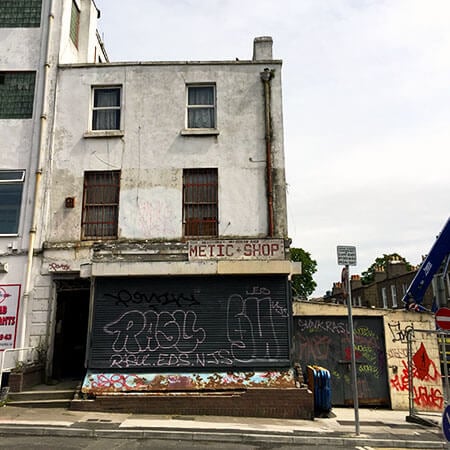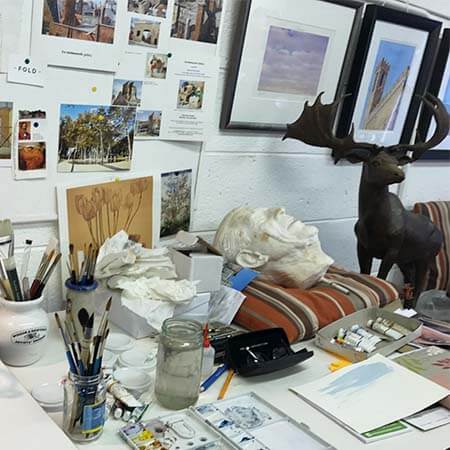Artist residencies run by Dublin City Council
Dublin’s art scene is blossoming. A new wing has opened up in the National Gallery, IMMA continues to attract international work, the walls of the city are awash with commissioned street art. However, with an extremely competitive housing market and rising rents, how is the city looking after its artists?
Each year, Dublin City Council puts out a call for artists to live in its four subsidised residential spaces. It offers them for periods of three to ten months. They include two cottages in the leafy, tranquil Albert College Park in Glasnevin, a Temple Bar apartment and St. Patrick’s Lodge beside the cathedral.
Back in 2017, Dublin.ie spoke to two of the people taking up the city’s artists residencies to find out how this opportunity affects their lives and work.
Michael McLoughlin
I met Michael McLoughlin for a chat amidst the bustle of the busy café of the National Gallery. Michael is a multimedia artist from Palmerstown, living in the Albert Cottages. In the past, he has also had residencies in UCD, Droichead Arts Centre and is currently with Draíocht.
Having spent time on projects in Limerick and in the Art House in Stradbally, he accepts that a transient life is an artist’s lot. “I’ve been kind of moving around from project to project,” he says.

Michael’s work focuses on the networks people build around themselves in a community.
“I work a lot in different social contexts,” he says. “There was a project I was working on for Dublin City Council in Crumlin and Drimnagh, a book of drawings called ‘I’m here because I know you will be too’. It was about places where people meet up in a community, the places where you’re missed.”
On his iPad, he shows me his work in Limerick City Gallery: a large room filled with speakers suspended from the ceiling.
I don’t think it would be possible to be in Dublin without it.
“Each cluster of speakers, they’re spatial recordings of 15 different community groups all over the city,” he explains. You walk through leaning into different conversations.
He’s interested in the gallery as a public space and art as “a mechanism for this conversation between these public institutions and the people that they’re there to serve.”
The National Gallery where we’re sitting is a space Michael regards as more democratic than many contemporary art venues “that exist just for art audiences. I just like this idea of art as part of everyday life…”

Michael studied sculpture in Limerick until 1994. “I’d find it harder if I was leaving college now,” he says. “There was more of an acceptance that people might spend time figuring out what they’re going to do. In 1994, expectations were [lower]. I got involved in organising exhibitions and street theatre stuff.”
His work is not a “market-dependent, sales-based art”. So a lot of his projects have been with colleges and communities.
One project, ‘Welcome Back’, with Dublin City Council in Ballymun focused on “the journeys people made from the Towers to come down to their new houses”. Michael constructed icons based on their collective memories. The work hangs on the walls of Poppintree Community Centre.
He enjoys this sort of community-based art that has a remit beyond the art object itself. “You’re learning and coming to some sort of understanding,” he says.
It’s very different to what he describes as the prevailing idea of art practice, where artists exist in a bubble separated from society – “like some sort of oracle”. In Dublin, he sees “a real sense of work being made for communities.”
The residency allows for a relationship with the city.
Of this artist residency opportunity, he says: “I don’t think it would be possible to be in Dublin without it. Each time [you make an application], you say ‘This is what I do and this is what I’m at for a couple of years’. And it’s an acknowledgement of all the work you do. I know that my year is more productive than it would have been.”
It also grants him just the right amount of solitude. “You’ve security, that feeling of solitude,” he says. And also a sense of the communities with which he works.
“You don’t come across connections in the same way if you’re away,” he says. “The residency allows for a relationship with the city.”
Being based right inside a park brings its own delights too. Michael talks about foxes and squirrels on the windowsill and “unbelievable” birdsong.
“In the city. It’s a real gem,” he says. “You’re on this rise above the city. I always forget about that – the view from Ballymun. You’re literally at the top of the hill.”
Seamus Nolan
Later in the week, I met with artist Seamus Nolan, who invited me up to his Wooden Buildings apartment in Temple Bar.
We step through a large iron gate to the relative quiet of the building’s leafy garden.
 Seamus won a commission with the Hugh Lane Gallery and Create Ireland. A six month artist residency in this apartment was part of it.
Seamus won a commission with the Hugh Lane Gallery and Create Ireland. A six month artist residency in this apartment was part of it.
Previously, he had been living in another artist residence in the old Fire Station on Buckingham Street.
“It just so happened I was leaving there and I got the award, so it’s perfect,” he says. “I can’t afford to live in Dublin anymore”.
Still in the research stages, his new project involves working with Traveller rights organisation Pavee Point.
Proximity to the city is vital. “It’s based on the north side, but I’m using different collections and national archives, so I need to be in Dublin,” he explains.
Seamus takes a tin cup from the cupboard. He made it on a tinsmithing course with some men from Pavee Point. ‘Property is Theft’ is stamped into the lip of the cup. He turns it in his hands delighting in its craft.
We talk about some of Seamus’ older work. He famously made-over a Ballymun Tower to create ‘Ballymun Hotel’, renting out rooms for the night at a price of people’s choosing.
All I needed was somewhere to live.
He also attempted to hijack a commercial flight. This was “a sort of non-participatory project”, which involved buying all the tickets for a flight and not showing up. It was about “taking control over something you have absolutely no control over,” he says. “Pursuing your own agency and seeing what is possible as a normal person”.
His work tends to focus on marginalised communities or not being allowed to participate. “As a citizen of the state, what is your voice and how do you take charge of your own representation,” he says.
Seamus is from a farming background in Kilkenny. However, he studied at NCAD until 2004 and has lived mostly in Dublin. He works as an art teacher to pay the bills – in a “school for kids who get kicked out of schools”.
Like Michael, he accepts the transient nature of this life. “I moved all my stuff down to my dad’s shed. Luckily, there’s somewhere to put stuff,” he says. “All I needed was somewhere to live… Artists are always working without getting a huge return, so it helps to have a space like this.”
It’s amazing for someone else to support what you’re thinking about…
Again, proximity to Dublin is preferable. As we sit at his kitchen table beside open balcony doors, we can hear bagpipes in a neighbouring apartment, then seagulls. Seamus reflects on the grant application process – an inherent part of artistic life.
“It’s kind of strange when you’re a visual artist. You’re constantly putting out these texts, because you’re writing applications to quantify what you do and how you’re going to do it,” he says. “It’s amazing for someone else to support what you’re thinking about and having those outlets is really amazing.”
In the US, for example, artists have to seek private funding. “The work has to be geared towards some kind of product and has to fulfil the art market objectives,” he says. So he appreciates Dublin’s artist residencies. “We’re very privileged in that way”.
To find out more about the council’s artist residencies, visit The Dublin City Arts Office’ website.


